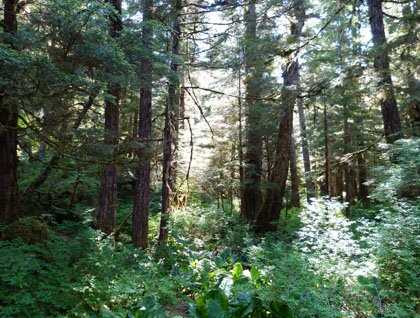After leaving Sitka yesterday evening, the National Geographic Sea Bird entered the narrow waterways of Alaska's Inside Passage, traversing Peril Strait which separates the large islands of Baranof and Chichagof. A few who stayed up late reported a beautiful full moon. The pull of that moon was evident in the massive tidal range that we witnessed today: a fifteen-foot change from the morning low to the afternoon high. In the early morning, we were in Chatham Strait, along the east coast of Baranov Island, discovering the joy of a steaming mug of coffee on the foredeck, looking for birds and watching Alaska go by. Humpback whales spouted in the distance, rising to the surface to breathe and then returning to the depths to feed. We poked our bow at a beautiful waterfall bringing snowmelt from the mountains above, and we cruised into Kelp Bay searching for wildlife on the shore.
For our afternoon activities, we reached Hanus Bay, near the northeast corner of Baranof Island, where we took our first walks through the magnificent temperate rain forest. The climate of Southeast Alaska is moderated by the influence of Pacific Ocean water. It is neither warm in summer nor cold in winter, hence "temperate." Huge trees of Sitka spruce and western hemlock, both reaching 200 feet in height, dominate the forest. But one of the diagnostic features of the rain forest is the abundance of living plant biomass at all levels of the forest. A carpet of moss, ferns, and tiny flowering plants covers the forest floor. Above these are small shrubs, then larger shrubs like bush blueberry and huckleberry. Then come the tree saplings and young trees, and above these is the canopy of mature trees. Collectively, these make up a mass of green tissue (biomass) that meets or exceeds the rest of the world's ecosystems. Looking out through the forest, we saw shafts of sunlight coming through light gaps, perhaps where a canopy-level tree had died and fallen, to allow light to reach the forest floor. We saw abundant evidence of the recruitment of new trees on nurse logs—fallen trees, now moss covered and providing a perfect seed bed for the next generation of forest trees.
A stream passes through the forest. We were a bit surprised to see that salmon were already making their way into fresh water, where they will spawn and die, feeding bears, eagles, otters, wolves, and even flies that feed the songbirds, and adding new nutrients that fuel plant growth. The stream also provided a path for kayakers to penetrate into the forest, until they reached a cascade of water passing over the rocks. Here, the kayakers stopped, but the salmon must pass this and many other barriers, as well as the gauntlet of predators, to reach the end of their journey. Some will succeed. Sockeye salmon will spawn in Lake Eva, chum and pink salmon in the gravel of the stream, and the life of the forest will go on. Or so we hope.







